Hello, everyone. My name is Daichi, an expert providing the information about the radiation issues in an easy-to-understand manner.
In the previous article, changes over time of evacuation orders, after its establishment to reorganization, after the accident of the Fukushima Daiichi Nuclear Power Station, as well as definition of the Restricted Areas, established after the reorganization of the evacuation areas, were covered as a review of previous articles.
This article elaborates changes over time of the Restricted Areas, after the reorganization to this date, as well as the Specified Reconstruction and Revitalization Base Areas, newly established in the Restricted Areas.
In other words, this article responds to the following questions:
– How much Restricted Areas are still remaining to this date?
– What is the Specified Reconstruction and Revitalization Base Areas?
Table of contents of this article
- (What is the SRRBA?) Restricted Areas (Vol. 2)
- Changes over time of the Restricted Areas after the reorganization of the evacuation areas
- Lift of evacuation orders in the Restricted Areas during the above-mentioned period of time
- What is the SRRBA?
- Overview of the SRRBA
- Changes over time of the construction of the SRRBA
- Summary
I have been involved with the radiation-relevant issues, like the policy on the decontamination activities and the management of the Interim Storage Facility, after the accident of the Fukushima Daiichi Nuclear Power Plant in 2011.
I received a doctorate in the field of radiation, while working in Fukushima.
(What is the SRRBA?) Restricted Areas (Vol. 2)
First, let’s look at the changes over time from August 2013, when reorganization of evacuation areas was completed, to March 2020, when all evacuation orders were lifted other than the Restricted Areas (the Habitation Restricted Areas and the Preparation Areas for Lift of Evacuation Orders).
Changes over time of the Restricted Areas after the reorganization of the evacuation areas
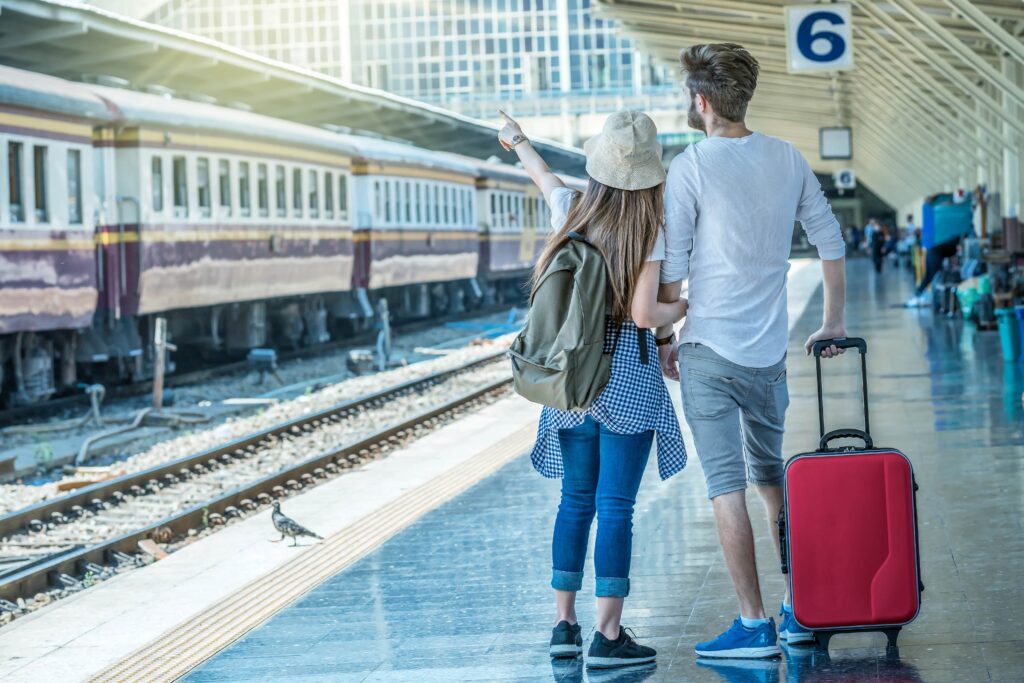
As elaborated this article, the evacuation orders were issued on the date of disaster, March 11, 2011, and as the situation of environmental contamination had become apparent, caused by radioactive materials released into the environment (please refer to this article for detailed information), the evacuation areas were accordingly expanded.
After that, the evacuation areas were gradually reorganized, taking into account dose to the public, and the reorganization was completed in August 2013, into the ‘the Restricted Areas’, ‘the Habitation Restricted Areas’ and ‘the Preparation Areas for Lift of Evacuation Orders’, as represented in the following figures.

↑August 8, 2013
After that, in the evacuation areas, other than the Restricted Areas, that is, the Habitation Restricted Areas, the Preparation Areas for Lift of Evacuation Orders and the Specific Spots Recommended for Evacuation, the evacuation orders had been lifted gradually and in a step-by-step manner by March 2020, by taking around 6 and half years, as shown in the following figure.
For more detailed changes over time for the evacuation areas, please visit this article and this article.
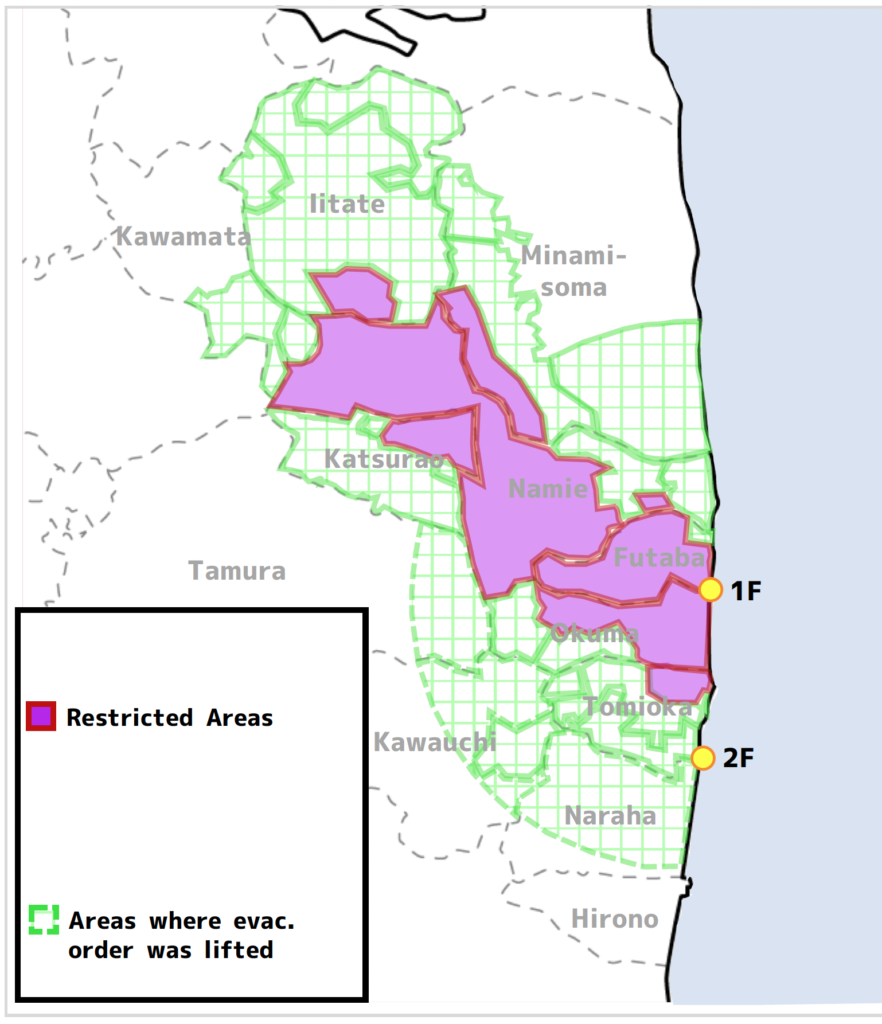
↑March 10, 2020
Lift of evacuation orders in the Restricted Areas during the above-mentioned period of time

During this period, entry into the Restricted Areas had been strictly restricted, for example by installing barricades, except for the temporary entry of residents, as covered this article, but there were other cases in which the entry into the Restricted Areas had been admitted.
First example is, so called the ‘through-traffic’.
In other words, in terms of radiation protection, it was allowed to pass through the major roads (e.g. the Route 6) in the Restricted Areas, without getting off the cars (there was a period of time, when traffic of a motorcycle was prohibited).
Another example is, lift of evacuation orders of the JR Joban Line stations, as well as roads around the stations.
In line with the full reopening(restoration) of the JR Joban Line on March 14, 2020, decontamination activities had been implemented in advance, and evacuation orders had been lifted by March 10, 2020, for the JR Joban Line stations and roads around the stations in the Restricted Areas, in Okuma Town, Futaba Town and Tomioka Town.
This event was a big progress for reconstruction of the affected areas, but areas themselves were very small, taking account of the size of whole Restricted Areas.
At the same time, as an approach for lift of evacuation orders in the wider range of the Restricted Areas, new policy: ‘the Specified Reconstruction and Revitalization Base Areas’ was established, and the activities to promote their construction have been continued so far.
In the following parts the activities will be elaborated in detail.
What is the SRRBA?
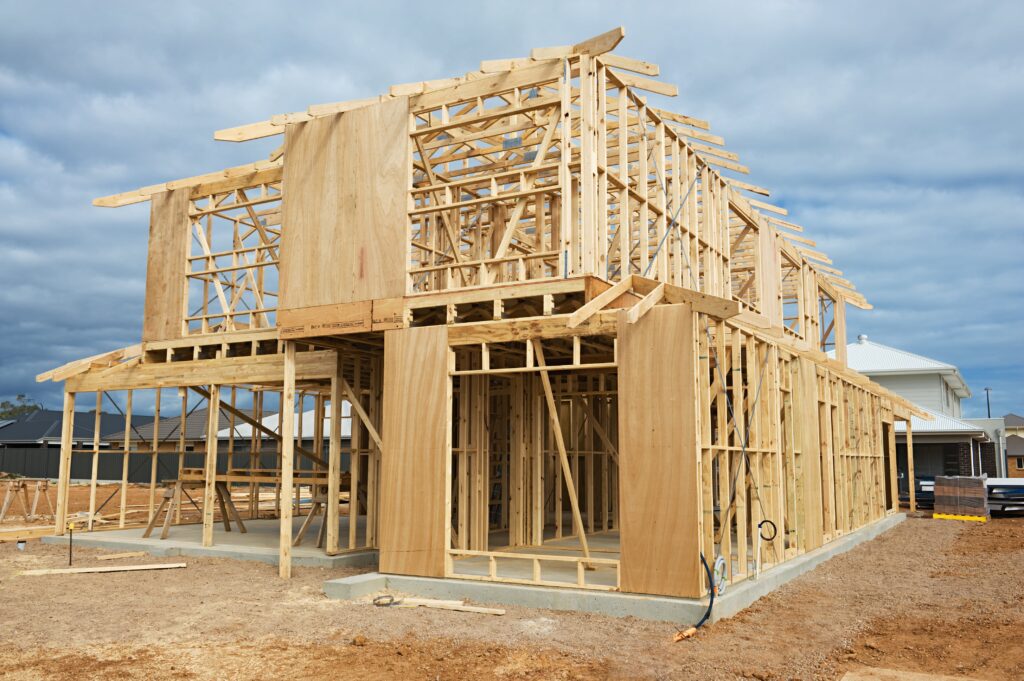
Although they are quite small parts of the whole areas, in conjunction with the above-mentioned measures toward lift of the evacuation orders in the Restricted Areas, institutional arrangement for the Restricted Areas was reviewed, toward lift of evacuation orders for whole Restricted Areas.
Specifically, the new area named the Specified Reconstruction and Revitalization Base Areas, was established to promote lift of evacuation orders and return of people.
The detail will be covered in the following parts of this article.
Overview of the SRRBA

The Specified Reconstruction and Revitalization Base Areas are the areas, where people are allowed to live after lift of evacuation orders in the Restricted Areas, and of the 7 municipalities which include the Restricted Areas, the areas had been constructed in Futaba Town, Okuma Town, Namie Town, Tomioka Town, Iitate Village and Katsurao Village.
With regard to Minamisoma City, the Restricted Areas are situated in the mountainous areas, where people had not lived before the accident, so the Specified Reconstruction and Revitalization Base Areas were not constructed.
Each municipality developed a plan for construction of the areas, and if the prime minister approves the plan, off-site decontamination activities and development of infrastructure had been intensively implemented, aiming at creating environment for returnees withing the areas.
However, there are conditions for approval of the plan e.g.:
- Reduction of dose rate by decontamination activities to the level below the criterion, low enough for the lift of evacuation orders within around 5 years
- Landform appropriate for habitation of people and economic activities
- Preparation of access to outside the Restricted Areas
- Size of areas in which effective construction of the areas (SRRBA) is possible
Changes over time of the construction of the SRRBA
First of all, on June 12, 2022, in Noyuki District, Katsurao Village, the evacuation order in the Specified Reconstruction and Revitalization Base Areas with the area of around 95ha was lifted (Please refer to the below figure).
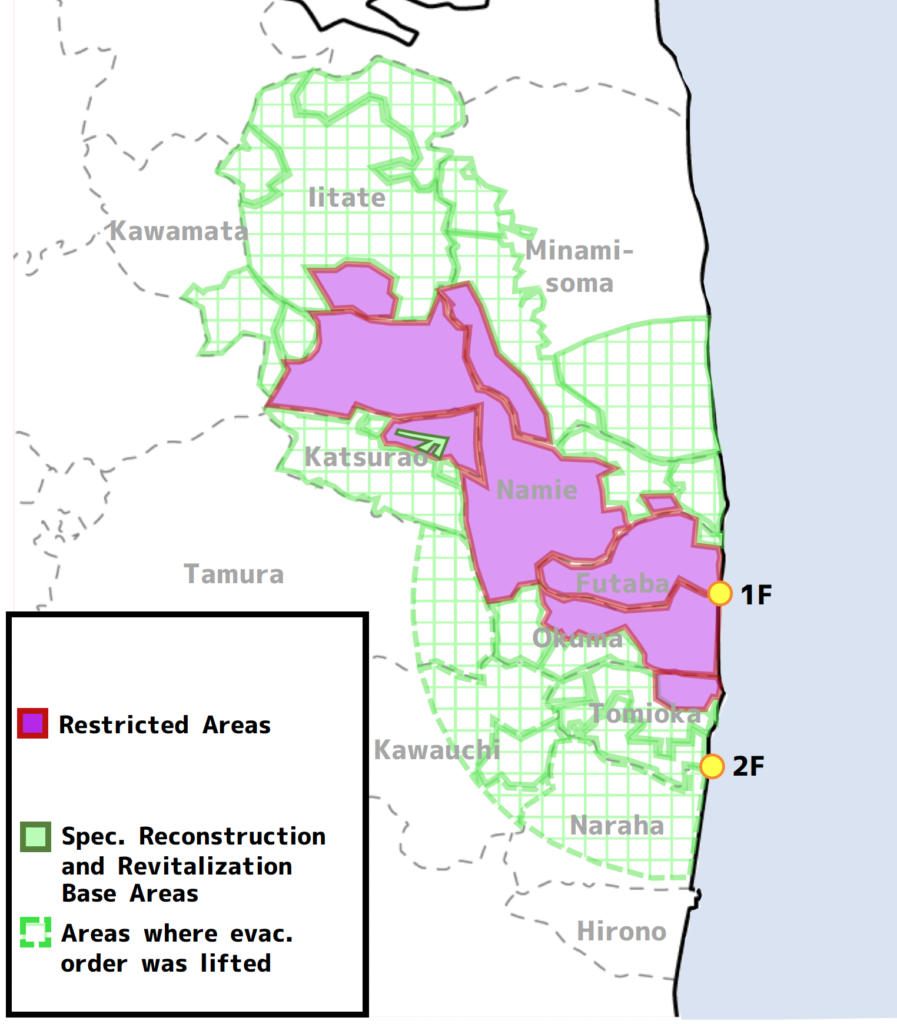
↑June 12, 2022
For the next, on June 30, 2022, in Shimonogami District etc., Okuma Town, where the former center of the town before the accident is situated, like JR Ono Station and the former Town Hall, the evacuation order in the Specified Reconstruction and Revitalization Base Areas with the area of around 860ha was lifted (Please refer to the below figure).
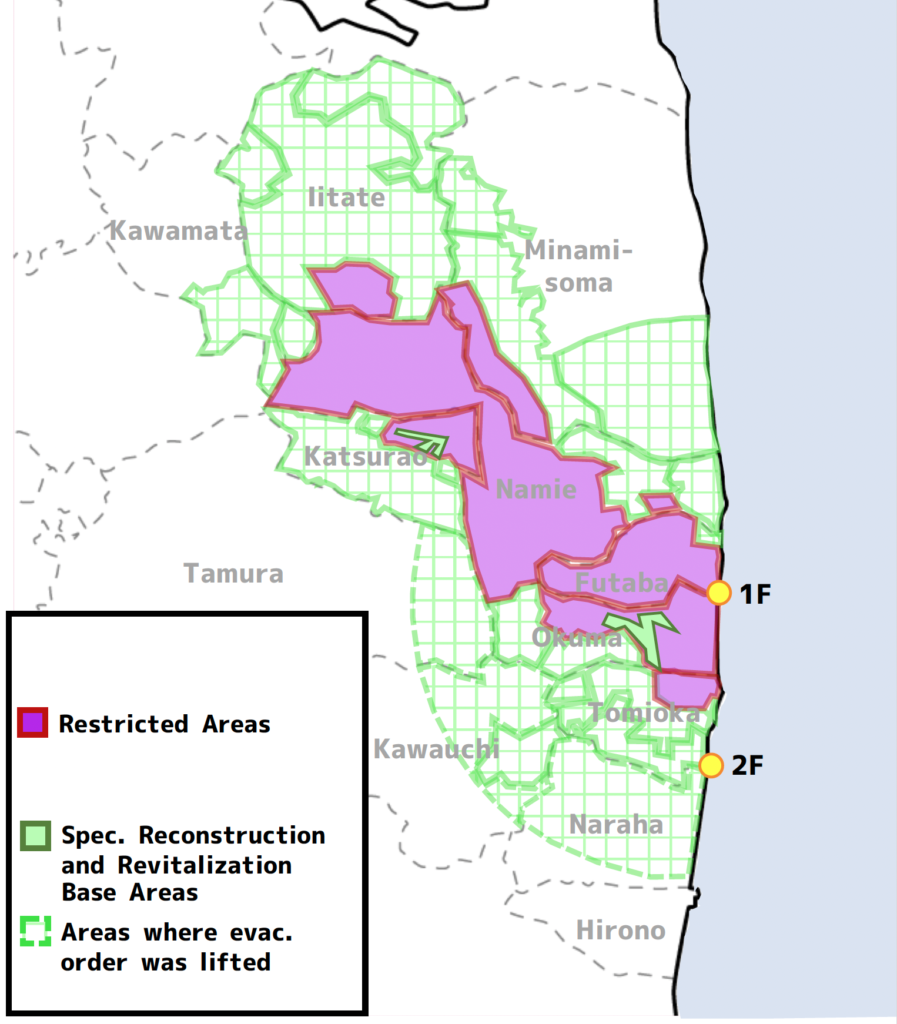
↑June 30, 2022
For the next, 2 months later, on August 30, 2022, in Futaba Town, in the areas around the JR Futaba Station etc., where the new Town Hall is situated, the evacuation order in the Specified Reconstruction and Revitalization Base Areas with the area of around 555ha was lifted (Please refer to the below figure).
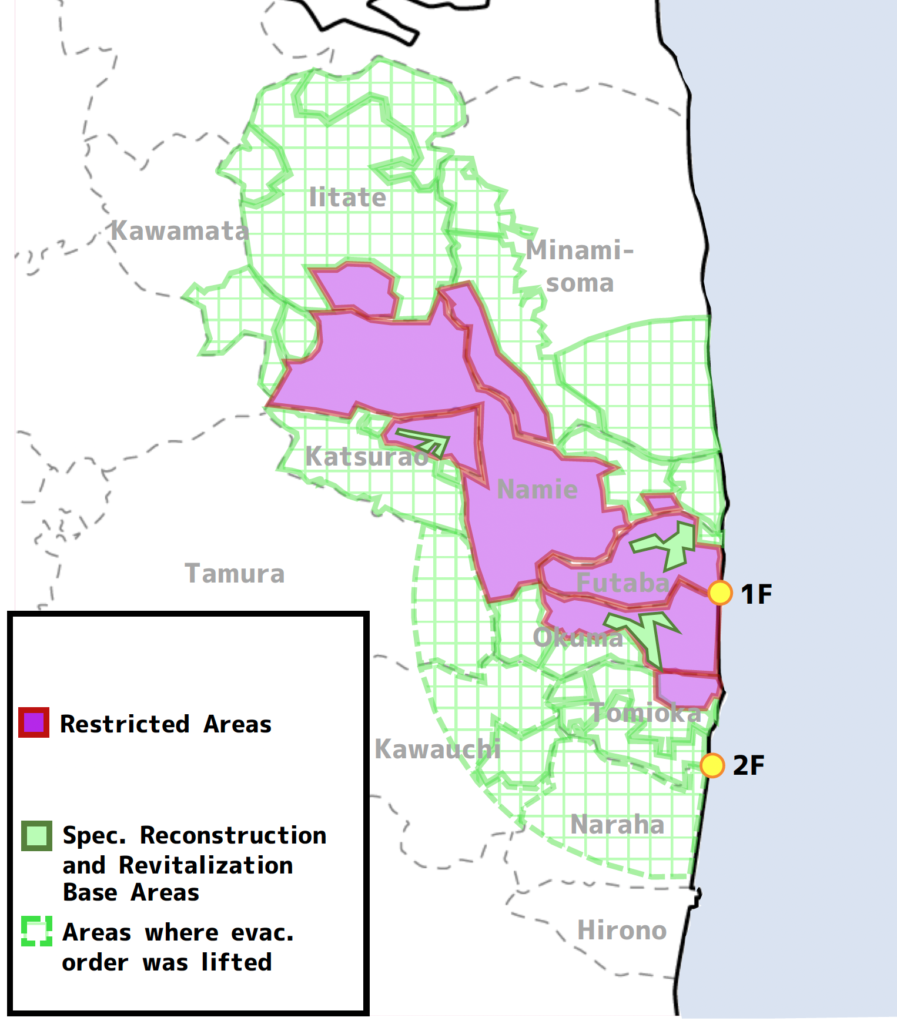
↑August 30, 2022
For the next, on March 31, 2023, in three administrative districts (Murohara, Suenomori and Tsushima) in Namie Town, including Tougei-no-Mori-Oobori and Oobori-Soumayaki-no-Sato, the evacuation order in the Specified Reconstruction and Revitalization Base Areas with the area of around 661ha was lifted (Please refer to the below figure).
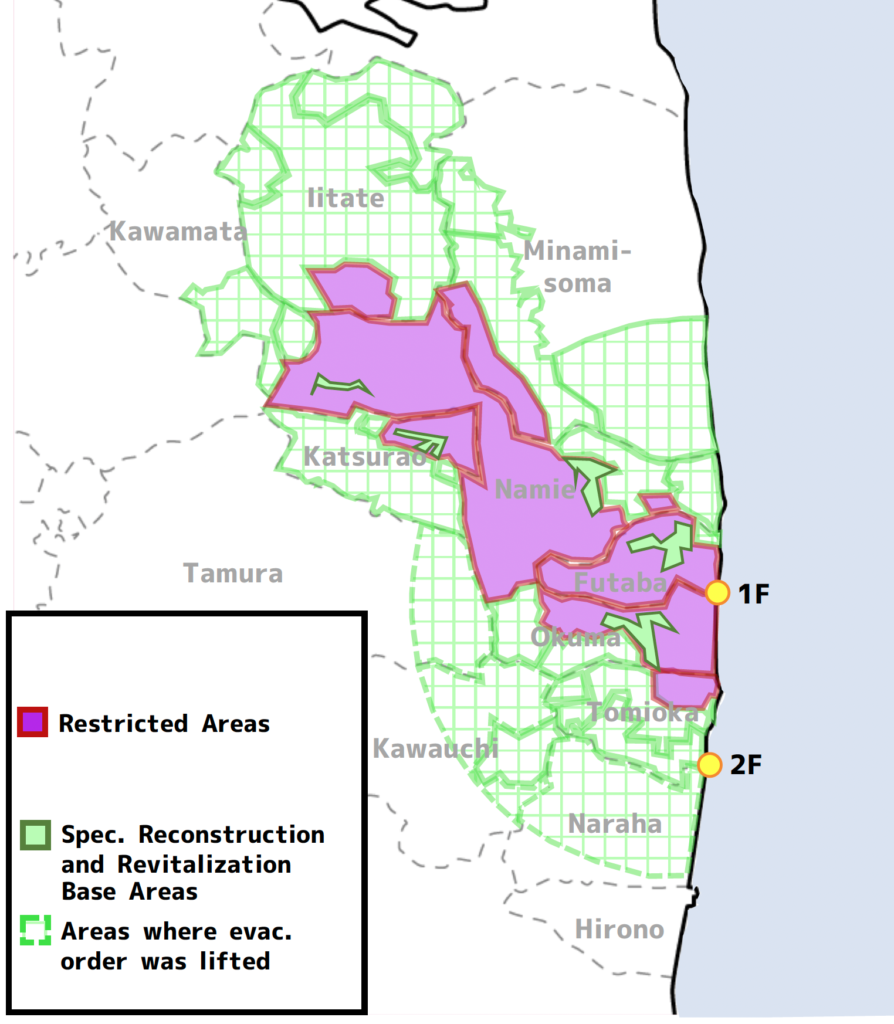
↑March 31, 2023
On the next day, on April 1, 2023, in Yonomori and Oosuga administrative districts, including the surrounding areas of roads of cherry blossoms with a total length of 2km, a symbol of Tomioka Town, the evacuation order in the Specified Reconstruction and Revitalization Base Areas with the area of around 390ha was lifted (Please refer to the below figure).
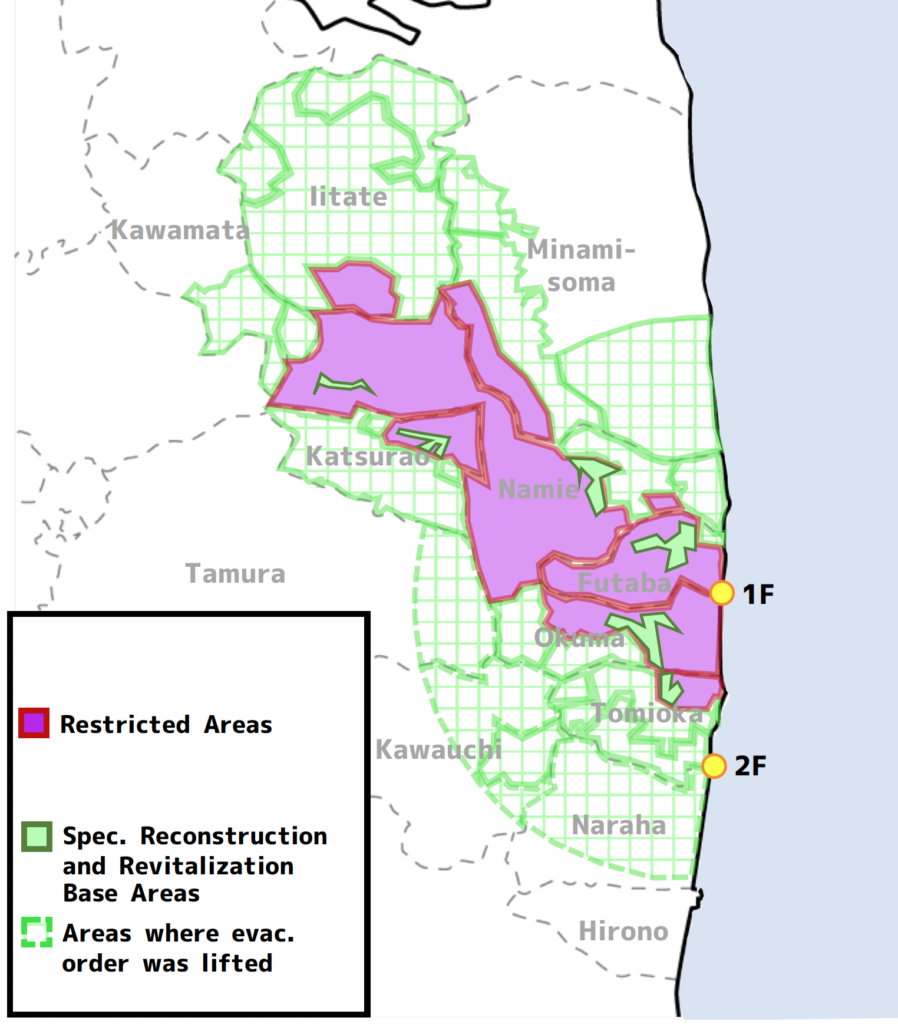
↑April 1, 2023
At last, one month later, on May 1, 2023, in Nagadoro district located in southern part of Iitate Village, the evacuation orders in the Specified Reconstruction and Revitalization Base Areas with the area of around 186ha, and the neighboring park outside the Specified Reconstruction and Revitalization Base Areas (with the condition that nobody would live in the park), were simultaneously lifted (Please refer to the below figure).
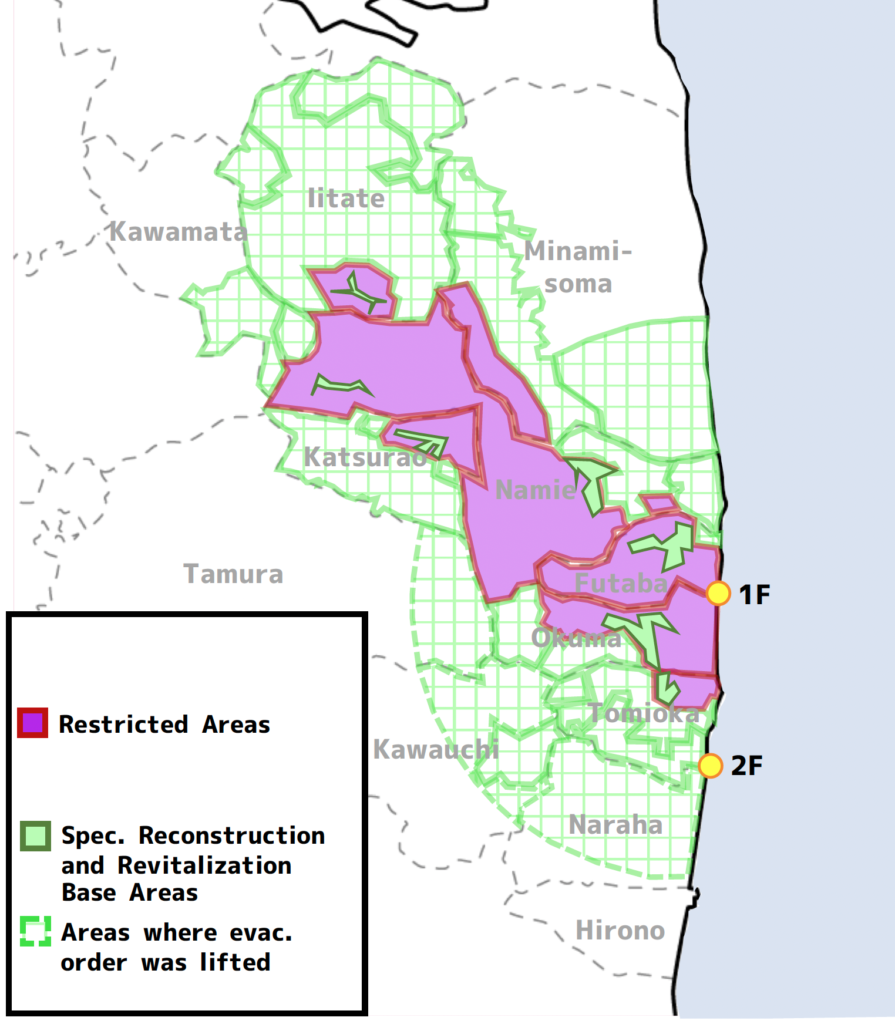
↑May 1, 2023
On November 30, 2023, evacuation orders of the Specified Reconstruction and Revitalization Base Areas in the graveyards, community center and roads leading to these places in the Restricted Areas in Tomioka Town were lifted.
All planned development and lift of evacuation orders for the Specified Reconstruction and Revitalization Base Areas had been now completed.
Approval date of each plan of each Specified Reconstruction and Revitalization Base Areas, date of lift of evacuation order etc. are summarized in the following table.
| Municipality | Approval date of plan | Starting date of construction | Area of SRRBA | Date of lift of evacuation order |
|---|---|---|---|---|
| Futaba Town | Sep. 15, 2017 | Dec. 25, 2017 | Approx. 555ha | Aug. 30, 2022 |
| Okuma Town | Nov. 10, 2017 | Mar 9, 2018 | Approx. 860ha | Jun. 30, 2022 |
| Namie Town | Dec. 22, 2017 | May 30, 2018 | Approx. 661ha | Mar. 31, 2023 |
| Tomioka Town | Mar. 9, 2018 | Jul. 6, 2018 | Approx. 390ha | Apr. 1 and Nov. 30, 2023 |
| Iitate Village | Apr. 20, 2018 | Sep. 28, 2018 | Approx. 186ha | May 1, 2023 |
| Katsurao Village | May 11, 2018 | Nov. 20, 2018 | Approx. 95ha | Jun. 12, 2022 |
Summary
This time as a continuous work from this article, changes over time of the Restricted Areas after its reorganization, examples of lift of evacuation orders in the Restricted Areas at that time (e.g. stations of JR Joban Line), followed by overview and history of lift of evacuation orders in the Specified Reconstruction and Revitalization Base Areas, as following larger-scale lift of evacuation orders in the Restricted Areas.
Policy on the remaining Restricted Areas will be elaborated in the next article.
By the way, above-mentioned contents are summarized in the following videos.
It would be appreciated to visit them at your convenience.
– Japanese version
– English version
You can read the same article in Japanese here.
Thank you very much for reading this article.
See you next time!
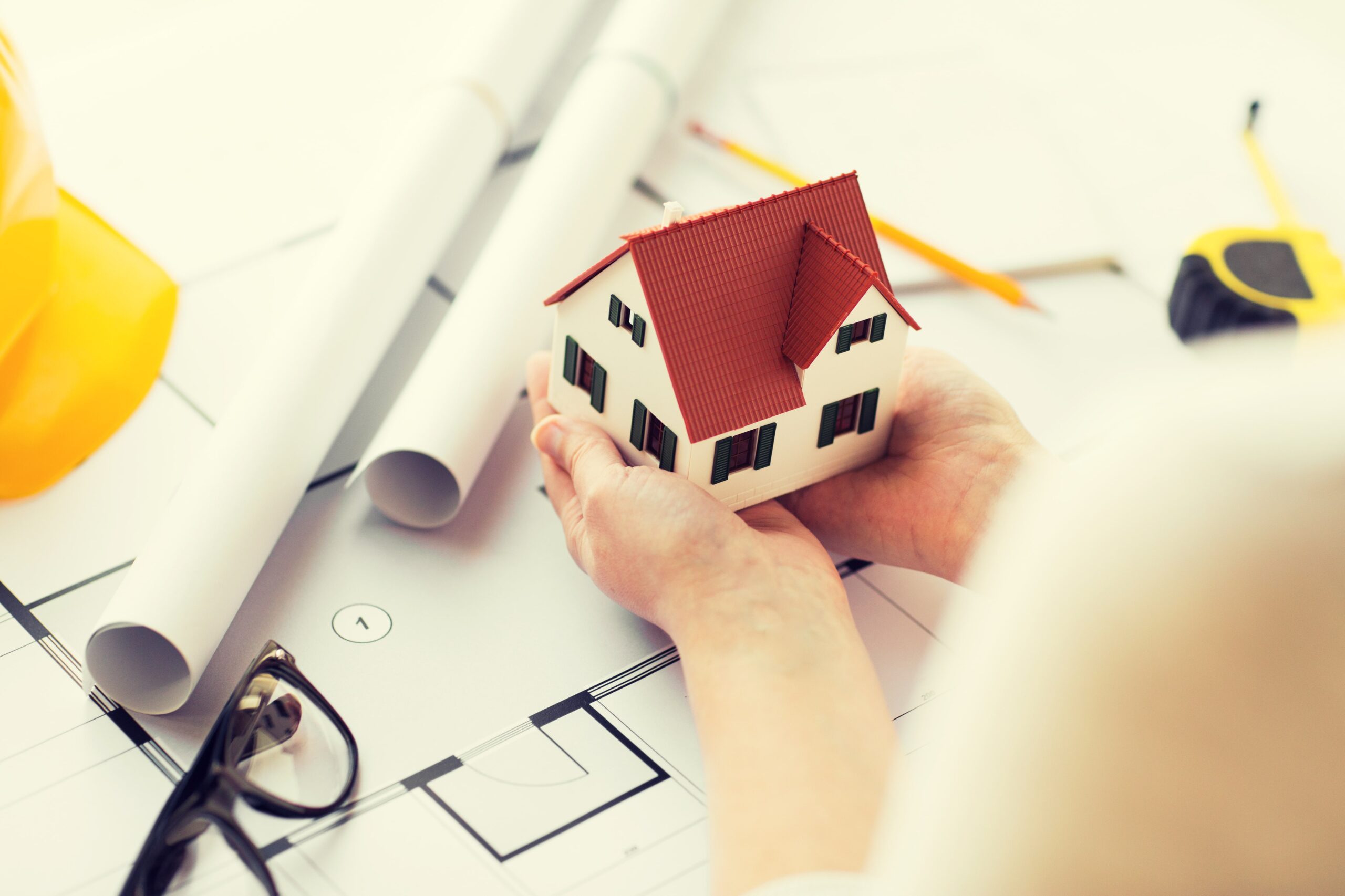


コメント